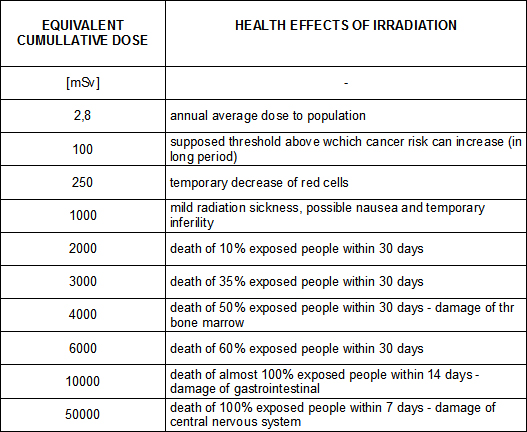
ENVIRONMENT
Ionizing radiation and its doses
Radiation is present everywhere on the Earth. It is electromagnetic wave, that transmit the energy. Small amounts of energy are not harmful. To this group, light, TV, radio, communication radiation can be divided. Second group, it is radiation with much greater energy. It is high enough to knock out an electron from the orbit of the atom and form an ion. Ionization introduces changes in physicochemical properties of living cells, especially in deoxyribonucleic acid molecules (DNA). [19] Ionizing radioactivity is an effect of continuous transformation of atoms. Disintegration occurs and some particles are emitted. But there are several types of radiation [19],[82],[104]:
It is necessary to measure the radiation. However single power of radiation in some case is not sufficient because it does not accord to human body effects or does not include type of radiation. Hence several factors are used to radiation description [19], [104] ,[105],:
Above units concern single doses or cumulative dose, but in many cases the concept of dose rate it used. It represents dose in relation to the exposure time, i.e. Sievert per hour (Sv/h) or Sievert per year (Sv/y). Radioactive materials and particles normally occurs in living environment. Thus, we are exposed to the harmful radiation. However its intensity is so low that it does not develop health effects according to [105]. Overall, annual, average dose to the population, according to [106] is 2,8 mSv. At about 85%, the source of radiation is natural, only at 25% radiation comes from man-made sources. Below, average example doses are presented [102], [107]:
According to [105], small doses of radiation is not harmful and do not causes negative consequences for human body. Damaged cells are able to repair. However accurate threshold is not set. It depends on body strength. It is also not decided yet how large doses start to make irreversible changes in tissues. Nevertheless everyone agree that too high radiation causes cancer and may damage structure of DNA. In such situation cells can die after irradiation or can be improperly repaired. Then risk of cancer develops, cells lose their functionality or there are some genetic consequences in the next generations.[82]

Source: Own development based on J. K u b o w s k i "Nowoczesne elektrownie jadrowe", Warszawa, WNT 2010, [19] "Nuclear Energy Today", Nuclear Energy Agency. Organisation for economic co-operation and development. OECD Publications 2003,2005 [82] R. W a r r y, "Q&A: Health effects of radiation exposure", BBC News, 23 March 2011, http://www.bbc.co.uk/news/health-12722435, [108]
-
Nuclear power industry|
Technology|
The electricity supply system aspect|
Economics|
Environment|
Public aspect|
Future|
Legislation|
References|

